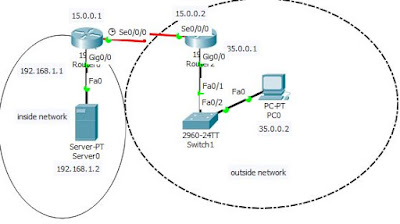Static Nat Configuration | In this
article we learn what is static nat , how to configure static nat and after configuring
verify the static nat in cisco router using packet tracer software.
What is NAT
Two types
of ip address are available in the network terminology. one is public address
and other is private address. In an organization internal network should use
private ip address to communicate each other ,normally is called LAN. These ip
addresses not used for the internet .They can not connect to the internet .To
overcome the limitation NAT is come to play is vital role .private ip address is
mapped to the public ip address to communicate to the internet and its hide the private ip address.
Type of NAT
Three types
of nats are available .
- Static nat
- Dynamic nat
- Natoverloading(PAT)
Static nat:
static nating is the type of nat where one private ip is mapped to the public
ip address.This is basically use when we are going to host webserver publicly.
Lab Diagram
How to configure static nat in cisco router using packet tracer
In the
above diagram we configure static nat in cisco router using packet tracer
software.
Static Nat Configuration
In the
internal network we have one web server with private ip address 192.168.1.2 and
its gateway is 192.168.1.1 which is configured in the router gig 0/0 interface
.In the above diagram there is another network which is 15.0.0.0/8 and there is
another network which is 35.0.0.0/8 both two networks are public.
We are
going to mapping web server private ip (192.168.1.2) to public ip (15.0.0.3).
To
configure it we need to execute the below steps.
Router>en
Router#conf
t
Enter
configuration commands, one per line. End with CNTL/Z.
Router(config)#ip
nat inside source static 192.168.1.2 15.0.0.3
Router(config)#int
gig0/0
Router(config-if)#ip
nat inside
Router(config-if)#exit
Router(config)#int
se0/0/0
Router(config-if)#ip
nat outside
Router(config-if)#exit
We have configured
static nat to execute the above commands.
Verify
of static nating
After
configured static nating we need to verify it whether it is configured or
not.To verify it we ping the webserver from the outside network.
Before configure
static nat when we going to ping the webserver from the outside network it get
the following output.
Packet
Tracer PC Command Line 1.0
C:\>ipconfig
FastEthernet0
Connection:(default port)
Link-local
IPv6 Address.........: FE80::290:21FF:FE1D:19C0
IP
Address......................: 35.0.0.2
Subnet
Mask.....................: 255.0.0.0
Default
Gateway.................: 35.0.0.1
C:\>ping
192.168.1.2
Pinging
192.168.1.2 with 32 bytes of data:
Request
timed out.
Reply
from 192.168.1.2: bytes=32 time=22ms TTL=126
Reply
from 192.168.1.2: bytes=32 time=16ms TTL=126
Reply
from 192.168.1.2: bytes=32 time=15ms TTL=126
Ping
statistics for 192.168.1.2:
Packets:
Sent = 4, Received = 3, Lost = 1 (25% loss),
Approximate
round trip times in milli-seconds:
Minimum
= 15ms, Maximum = 22ms, Average = 17ms
After configure
static nat when we going to ping the webserver from the outside network it get
the following output.
C:\>ping
192.168.1.2
Pinging
192.168.1.2 with 32 bytes of data:
Reply
from 15.0.0.3: bytes=32 time=17ms TTL=126
Reply
from 15.0.0.3: bytes=32 time=11ms TTL=126
Reply
from 15.0.0.3: bytes=32 time=23ms TTL=126
Reply
from 15.0.0.3: bytes=32 time=17ms TTL=126
Ping
statistics for 192.168.1.2:
Packets:
Sent = 4, Received = 4, Lost = 0 (0% loss),
Approximate
round trip times in milli-seconds:
Minimum
= 11ms, Maximum = 23ms, Average = 17ms
We execute
another command to verify the static natting.
Router#sh
ip nat translations
Pro
Inside global Inside local Outside local Outside global
---
15.0.0.3 192.168.1.2 --- ---
tcp
15.0.0.3:80 192.168.1.2:80 35.0.0.2:1025 35.0.0.2:1025
tcp
15.0.0.3:80 192.168.1.2:80 35.0.0.2:1026 35.0.0.2:1026
If this article is helpful to know about Static Nat Configuration please share and subscribe this article.
If this article is helpful to know about Static Nat Configuration please share and subscribe this article.


0 comments:
Post a Comment